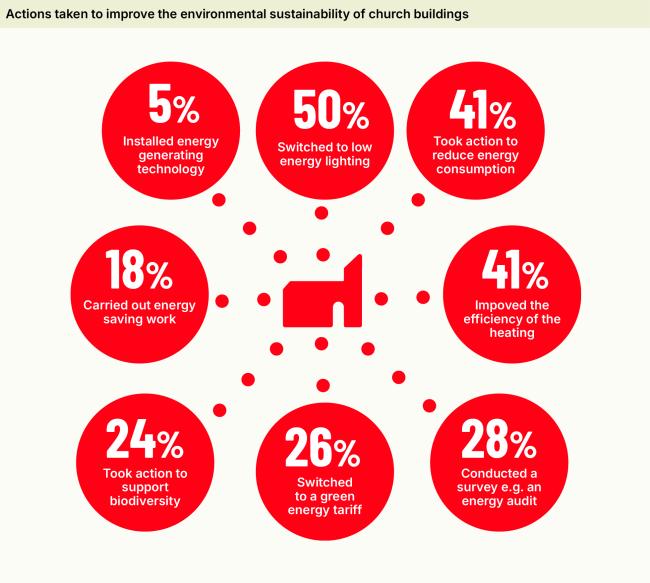
Church buildings and the challenge of climate change
Churches are not standing still when it comes to meeting the huge challenges posed by a changing climate. Many are making changes to their buildings to make them windtight and waterproof; it is easier to heat a dry church than a damp one. But they are also taking steps to reduce their buildings’ carbon footprint and make them more environmentally sustainable, which may be underpinned by their theological conviction for caring for both people and wider environment.
When asked “What actions have you taken to improve the environmental sustainability of your church and its buildings?”, churches revealed a picture of widespread, practical action. Many of these upgrades could be driven by the sharp rise in energy prices in 2021-22, which forced many churches to act quickly.
Encouragingly, this marks a clear shift in emphasis from earlier surveys. In 2010, 36% of churches reported making heating improvements, though these were framed as part of general maintenance and building care, rather than environmental sustainability. But by 2025, the figure has risen to 41%, with actions taken such as replacing old boilers, upgrading thermostats, zoning heating, or adding insulation.
These measures are explicitly recognised as a response to recent years: what was once seen simply as upkeep is now understood as central to protecting heritage, reducing running costs, and contributing to wider environmental goals.
A promising sign is the uptake of audits. 28% percent of churches have carried out an energy survey or audit, some supported by denominational schemes such as the Church of England’s ‘Energy Footprint Tool’ and the Parish Buying network. These audits are critical for mapping long-term pathways to net zero and churches that have undertaken audits may be more likely to also apply for grants or plan phased investments.
When asked what would be most useful to churches in terms of “enabling greater environmental sustainability for your church buildings”, financial support topped the list, with 70% saying it would be “very useful.” Beyond funding, 56% pointed to the need for professional expertise, recognising that many environmental upgrades require specialist advice.

The real costs of adapting to the climate crisis
By The Revd Canon Dr Stephen Evans, Rector of St Marylebone
When the fourth iteration of St Marylebone Parish Church in central London was built in 1810, the roof, gutters and downpipes were designed to clear around two tonnes of water per hour. This was, then, more than enough to withstand even the heaviest of downpours.
Today, these downpours can deliver almost four tonnes of rain in an hour, and projected rainfall might well increase this to as much as eight or even ten tonnes per hour over the next two hundred years.
The roof at St Marylebone could no longer cope with the heaviest rainfall. The fact that the sheet aluminium roof cladding was, in some areas, no longer attached to the roof’s structure coupled with the all too obvious fact that the roof was directing water into the building rather than away from it, meant that urgent action had to be taken.
The decision was made to replace the roof with Welsh slate, from the same quarry used in 1810. Modest but extremely effective modifications were made to parts of the roof and all rainwater goods – gutters and downpipes –were redesigned and reengineered to ship up to ten tonnes of water an hour.
Making these necessary changes came at a huge cost and other key projects were put on hold or cancelled. The new roof cost more than £3 million, which included upgrading its insulation to international Passivhaus standards, helping to halve our use of
fossil fuels.
The work wouldn’t have been possible without substantial grants, including from The National Lottery Heritage Fund, the Culture Recovery Fund and Neighbourhood CIL. Recovering the full amount of VAT costs through the Listed Places of Worship Grants Scheme proved vital.
Ready for the future – but where does that leave other church buildings?
St Marylebone Parish Church – which is also home to a 12,000 patient GP practice, also runs a bursary-aided psychotherapy service and hosts a large number of concerts, art exhibitions, and community events – it now has a building that can cope with the changing climate for centuries to come.
St Marylebone has been in the fortunate position of being able to raise the substantial funds needed to address both present and longer–term climate change problems, but where is the money to come from that will pay for the expensive modifications needed to address the changes in climate which will affect historic church buildings across the UK?

